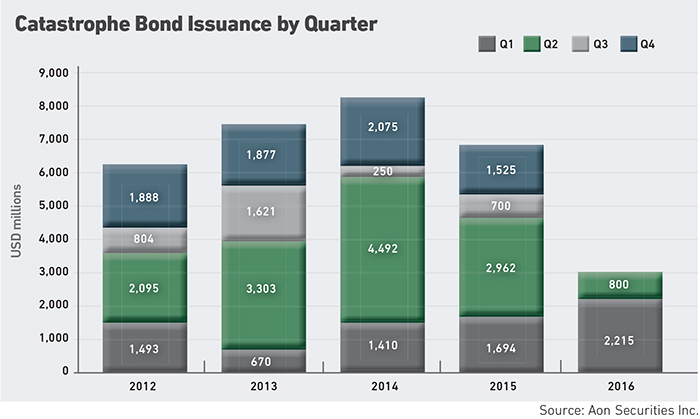Cyber Risk
Cyber Risks and ILS

As losses with cyber risks pile up, the insurance industry is looking for alternatives to offer capacity to buyers. Could capital markets hold the key to provide broader coverages and higher limits?
The answer may well be yes.
The race is on among underwriters and their advisers to develop CAT bond-like vehicles that could enable them to build extra layers of protection against cyber threats and to expand insurance and reinsurance capacity.
With pension funds and other institutional investors showing ever more appetite for insurance-linked securities (ILS), conditions appear to be set for a new market to flourish that could also extend in the future to corporations and government entities with a high exposure to cyber events.

Bill Dubinsky, head of insurance-linked securities, Willis Capital Markets & Advisory
“Many investors are looking for ways to take more risks,” said Bill Dubinsky, head of insurance-linked securities at Willis Capital Markets & Advisory. “Cyber risk is something that could work for them because a lot of it is catastrophic and it is generating real growth in insurance and reinsurance needs.”
The drivers behind the growth of ILS markets are the same that are pumping record levels of capital in the reinsurance industry.
As they look for alternatives to low-risk fixed income securities, institutional investors have taken a favorable view of CAT bonds and other ILS products, which offer solid rates of return and low probabilities of losses (although they tend to be huge when they take place).
But the development of a bond market to transfer cyber risks stumbles on difficulties that also affect the insurance industry in its dealings with a fast changing, hard to predict threat.
Cyber risks have fundamental differences with the catastrophes that constitute the traditional focus of ILS securities, which means that a lot of work still needs to be done before the new asset class takes flight.
“I do not think it is something that will happen quickly, but it is a natural evolution for the market,” said Ben Brookes, vice president of capital markets at RMS, the risk modeling firm.
Cyber Risks Are Unpredictable
One of the main challenges is that cyber risks are unpredictable and evolve all the time, and the same goes for the losses that they can generate.
“The scope of the coverages has continued to expand. Insurance contracts today have a much broader coverage than five years ago,” said Michael Carr, technology practice leader at Argo Group.
“For example, the privacy coverage has gone from just security-type triggers, such as hacking or malware, to any sort of privacy violation. In the area of business interruption, policies now also cover losses caused by failures of third-party software or even by failures of the insured’s own IT department.”
Companies use insurance coverages to protect their networks, physical structures and supply chains against cyber attacks, but they are also exposed to third-party liabilities, which should soon become the most important source of losses caused by cyber events.
The unpredictability of the peril frightens off investors who look at ILS investments as a source of portfolio stability in volatile times. Liability risks with a long tail are very likely to be the toughest one for asset managers to swallow.
So the first challenge that cedants and their advisers need to tackle before a cyber ILS market comes into shape is to develop reliable ways to measure, aggregate and model cyber risks, so that investors will feel more comfortable taking them in.

A very solid understanding of how the risk evolves is important as — different from hurricanes and floods — hackers learn from past experience, and they adapt their attacks accordingly.
“There is no standard way to quantify cyber exposures at the moment,” said Thomas Harvey, the product manager of emerging risks at RMS. “The human factor and the various motivations behind attacks add a huge element of complexity to the modeling of cyber risks. Also, the balance between attack and defense is shifting all the time.”
But he sees progress in this issue, as access to data on cyber attacks — for a long time a scarce commodity — is gradually becoming more available to the parties involved. Reporting rules in the U.S. are playing a large part in promoting the sharing of information, and the E.U. will make reporting on cyber attacks mandatory by 2018, Harvey said.
Big Data Models Cyber Risks
Some kinds of losses, such as extortion, which companies do not like to make public, present particular challenges, but modeling firms are negotiating with insurers and reinsurers to have access to all kinds of data about cyber events. Participants in the market have realized that sharing knowledge is good for everybody, Harvey said.
For example, the Association of British Insurers, ABI, made an appeal in May for the creation of a database with mandatory information about cyber incidents.
“We are confident it is possible to develop a mechanism to model cyber risks,” Harvey said. “Demand for it is strong, as there is a huge amount of risks that the insurance and reinsurance markets want to take on.”
But the uncertain nature of cyber risks also raises the question of what losses would trigger a contract. They could be either single, large events, or an aggregation of claims, according to Brent Poliquin, assistant vice president for insurance-linked securities at AIR Worldwide, the catastrophe modeling firm.
There are many ways that originators of insurance contracts can lose money because of cyber risks, some of them still unknown by the market, which make it much harder to pick a trigger than property destruction resulting from earthquakes or floods.
Separating cyber events from terrorism could be a difficult thing to do on some occasions. Hackers form a heterogeneous group, ranging from religious fundamentalists to corporate spies, government agents and activists, and as a result they can have many different targets and kinds of attacks in mind.
To make matters more complex, the main source of cyber events is usually found within the company, as employees are often at their origin, either maliciously or by accident.
The trigger issue should be an especially difficult one for reinsurance companies, which make use of ILS contracts to spread their own risks and reduce their regulatory capital reserves. If investors have doubts over the trigger events, or fear that contracts could end up in the courts, they will show little interest for them.
In Dubinsky’s view, one of the keys to tackle this issue will be to focus on proportional agreements, instead of the excess of loss deals that prevail today in the ILS market. By doing so, investors can share on the expertise of underwriters to deal with a complex and evolving risk.
Appetite for Cyber Risk
Even after the technical challenges are overcome, however, the appetite for cyber risk bonds may not be as strong as it has been for other ILS securities.
For instance, some investors consider that, differently from natural catastrophes, cyber risks may have a high level of correlation with other securities such as equities and bonds.
The reasoning is that, in the case of a large cyber attack against vital infrastructures, the economic effects could make the stock and bond markets stumble at the same time.
“Asset managers who focus on ILS portfolios should find cyber risks products appealing due to the very low correlation with natural catastrophe risks that they have in their portfolios,” Poliquin said.
“But there may be a challenge related to the root sources of capital that flow to these asset managers, such as pension funds. From their standpoint, they may potentially discourage an allocation of capital to cyber risks bonds because they could have a higher correlation with other investments that they are making.”

Paul Traynor, managing director, BNY Mellon
But demand for ILS products has been so strong that, in Dubinsky’s view, investors could be interested despite the correlation issue.
And, when a cyber ILS market becomes a reality, even individual companies with large exposures to the risk might be able to tap capital markets for further protection, in a similar fashion that corporations do today with CAT bonds.
In fact, Paul Traynor, a managing director at BNY Mellon, highlighted that an example of how the market could work was provided by Crédit Suisse, which issued in May a $222 million CAT bond to boost its coverage against operational risks like fraud and cyber crime.
“Take the case of a large financial corporation that has invested very heavily to protect itself against cyber risks, but for regulatory reasons, still has to put operational capital aside to cover that risk,” Traynor said.
If investors believe a cyber risk instrument is a sound investment, the corporation may get capital support from such a transaction.
This is a solution that could gain steam not only among banks, but also in other highly regulated industries such as telecommunications and health insurance, he said.
Traynor also thinks that the development of a cyber risks ILS market could go a long way toward helping underwriters make available more capacity for a segment where demand is booming, even if evaluating exposures remains a challenge.
“For regulatory reasons, it is very difficult for insurers to offer sizable cyber covers if they cannot model them,” he said. “What they can do is to structure a special purpose vehicle to keep some of their cyber risk exposure and move most of it to capital markets, where entities that are not as regulated as insurers are can take it in.” &










